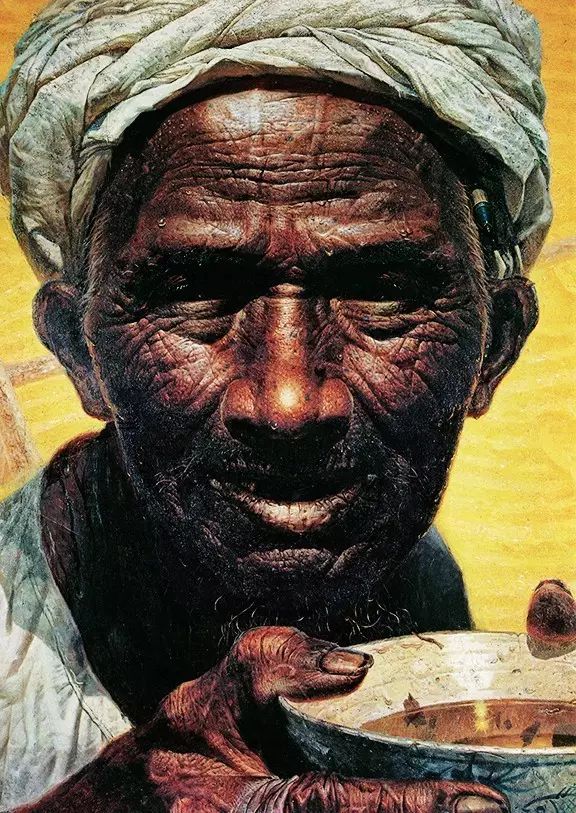A comment on
last week's posting
says Luo Zhongli's iconic painting
Father
may not easily create resonance among southern Chinese. I guess the villager’s white headcloth and the golden field at the back may suggest the painting portrays some one from rural northwest.
看到
上期的推送
有留言说,感觉罗中立的油画《父亲》不太容易让南方人产生共鸣。我猜是因为老农的白头巾和背景里金黄的田地,让人第一眼觉得画中的主角来自大西北。

罗中立《父亲》
Interestingly, Luo was a native of Chongqing. He produced the work when he studied at Sichuan Fine Arts Institute. His model was a senior villager living in Dabashan, a bordering area of Sichuan, Shaanxi and Hubei provinces. Luo once lived there for some 10 years before he went to college.
有意思的是,罗先生本人是重庆人。他创作这幅画的时候还是四川美术学院的学生。画的原型是大巴山的一位老农。大巴山位于四川、陕西和湖北三省交界,罗中立在上大学之前曾经在这里生活过近10年。
He named the canvas
My Father
, and submitted to a national competition and exhibition of young artists. Wu Guanzhong, a jury member (and a southern Chinese), renamed it
Father
, because he believed the painting not just portrays one single father, it shows the face of a generation of fathers.
一开始他给作品命名《我的父亲》,并用这幅画报名参加1980年的第二届全国青年美展。吴冠中先生是评委之一(也是南方人哦),他将其重新命名为《父亲》,因为他觉得作品描绘的并非一位父亲,而是对一代人的概括。
Luo expresses deep love and gratitude of the elder generation who worked hard and sacrificed a lot to support the country, whether they were from the south or the north, whether they lived in cities or the countryside. It conveys a spiritual power that is beyond the visual details and have touched a lot of people.
罗中立在画中表达了对父辈深深的爱和感激,这是不辞辛苦、不畏牺牲地支撑着国家的一代人,无论他们来自南方还是北方、生活在城市亦或是乡村。这幅画让观看的人越过这些表面的细节刻画,感受到一种巨大的精神力量和感动。
And that is why
Father
is one of the most traveling artworks in the collection of National Art Museum of China. "Father" is too busy, the staff often say.
这也是为什么《父亲》一直是中国美术馆最经常展出和巡展的馆藏之一。“父亲”很忙,工作人员也很“无奈”地说。:)
But I wonder whether you know that the museum shows other highlights in collection, at Treasure House, a small hall at its sixth floor.
但我不知道大家去中国美术馆的时候,有没有注意到六楼那个不大的展厅“藏宝阁”,这里展出了其他的重要馆藏。

吴冠中《太湖鹅群》

齐白石《老来红蝴蝶册页》
It was once a library for the staff and is now dedicated to the display of the museum's immense treasure trove.
这个厅曾经是内部的资料室,经过改造后成为馆藏陈列的专门展厅。
Next time you go there, do come to have a look at the works of our masters, spiritual treasures of our nation.
下次大家去中国美术馆的时候,别忘了到六楼的藏宝阁“瞻仰”这些大师的作品,也是我们民族的精神财富。

潘玉良《花摊》

林风眠《鱼鹰小舟》
The current display, through the end of the year, includes oil paintings, ink-brush paintings, calligraphy and sculptures, produced by the important figures of 20th-century Chinese art. Some of them are familiar to you, others may not.
目前的这批作品会展出到年底,有油画、中国画、书法和雕塑,来自20世纪中国美术最重要的一批人。有些人你们很熟悉了,有些可能没听说过。

秦宣夫《战时校园》

傅抱石《雨花台》
They are relatively small in size. But they are as glamorous as the pearls on a crown.
作品都不是很大,却如皇冠上的明珠一般闪耀。

关山月《北国牧歌》

颜文樑《红海》

陈抱一《月季花》

钱松喦《常熟田》

关良《西樵云霞古寺》

9 am-5 pm, closed on Mondays.

1 Wusi Dajie, Dongcheng district, Beijing.
Photos courtesy of National Art Museum of China
图片致谢中国美术馆
Lin Qi
自出道起专注特稿写作10余年,担任艺术报道是这两年的事。周一到周五去高大上的博物馆跑活儿,周末在798/草场地/黑桥出没。






